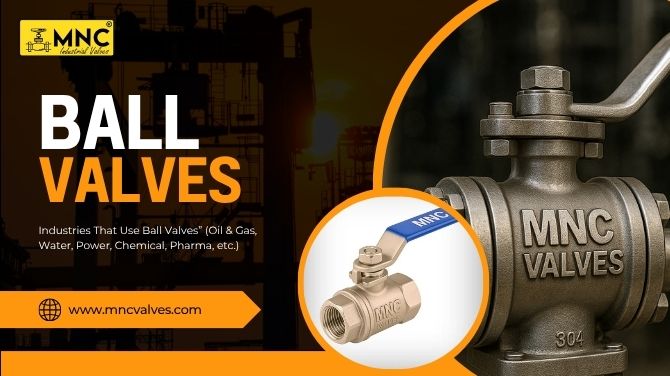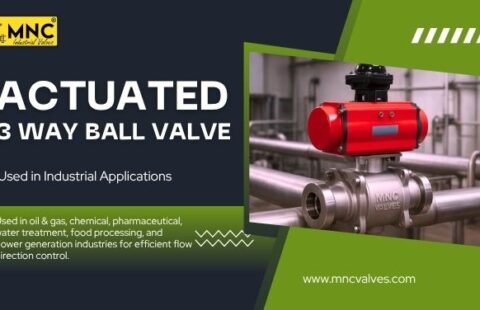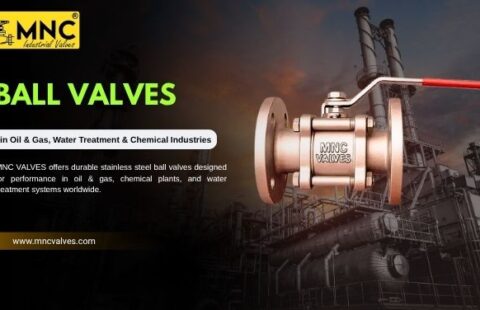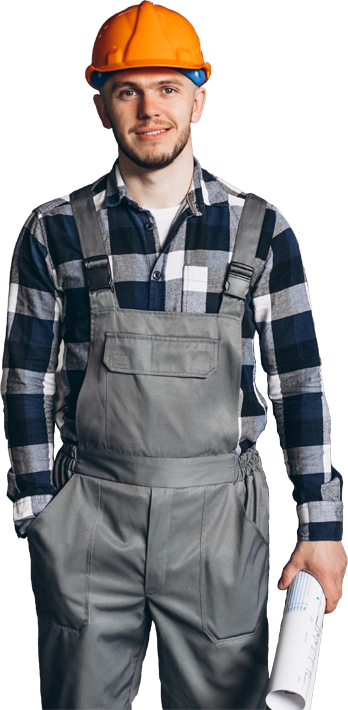
What Is a Ball Valve and Why Is It Essential for Industrial Operations?
Uptime is strategic in capital-intensive industries. Each valve in a process line either increases or decreases throughput. The ball valve’s compact design, tight shut-off, and quarter-turn simplicity make it stand out among these essential features. In addition to explaining why ball valves are essential in the oil and gas, chemical, water treatment, power, food and beverage, pharmaceutical, steel, and general industrial industries, this article demystifies ball valves—what they are, how they operate, and their main types and benefits. We also describe how MNC VALVES, Ahmedabad, provides large-scale, export-grade innovation and dependability.
What is a Ball Valve?
A ball valve is a quarter-turn shut-off valve that starts, stops, or reroutes media flow using a spherical obdurate (the “ball”) and a flow path (bore). Flow is open when the ball’s bore lines up with the pipeline; isolation is achieved when the ball is spun 90 degrees, blocking the passage with its solid side. Ball valves are a standard option for on/off and some modulating tasks in clean, slurry, viscous, and even high-pressure services because the contact mechanics between the ball and seats can provide nearly “bubble-tight” shut-off with minimum working torque.
How a Ball Valve Works (Mechanism & Components)
-
Core mechanism: The ball is rotated 0 to 90 degrees by a stem. When the bore is closed, it creates a positive barrier because it is perpendicular to the line, whereas when it is open, it is coaxial with it.
-
Seats: soft (PTFE, RPTFE) or specially designed composites for reduced friction and chemical compatibility. Metal-seated designs provide temperature and abrasion resistance for harsh service.
-
Body & End Connections: For flexibility in integration, one-, two-, or three-piece bodies with threaded, socket-weld, butt-weld, wafer, or flanged ends are available.
-
Sealing & Bearings: Body gaskets, bearings, and stem seals control torque loads, fugitive emissions, and lifecycle integrity.
-
Actuation: Simple manual levers and gears; remote, automated, or fail-safe control by pneumatic, electric, or hydraulic actuators (double-acting or spring-return).
Full Bore vs. Reduced Bore
-
Full bore minimizes pressure drop and permits pigging by maintaining pipeline ID through the ball.
-
Reduced bore maximizes weight and cost in situations where a slight pressure reduction is acceptable.
Floating vs. Trunnion-Mounted
-
Floating ball: For small and medium diameters and moderate pressures, the ball is supported by seats and “floats” gently downstream to seal.
-
Trunnion-mounted: Larger sizes, higher pressures, and consistent torque are best served by seats that are spring-loaded to the ball, which is anchored by trunnions.
Porting Options
-
2-way (standard isolation).
-
3-way / 4-way (L-port or T-port) for mixing, diverting, or manifold duties—critical for skids and compact process architectures.
Types of Ball Valves (Fit-for-Purpose Variants)
- One-, two-, or three-piece: bodies balance cost and serviceability; three-piece bodies enable in-line maintenance without interfering with end connections.
- Top-Entry: Upkeep from the top; perfect for crucial lines with limited footprint access.
- Metal-Seated: Slurry, abrasion, or high temperature services.
- Cryogenic: Extended bonnets and materials designed to withstand low temperatures.
- Fire-Safe Design: Secondary metal-to-metal sealing is used in fire-safe designs to reduce leakage routes.
- PFA/PTFE-lined or alloys: (CF8/CF8M, duplex, Monel) for harsh chemistry are lined and corrosion-resistant.
- Sanitary / hygienic: Cavity-filled seats, polished interiors, and tri-clamp ends for food and pharmaceutical cleanability are examples of sanitary and hygienic features.
- High-Pressure & Severe Service: Designed seating, trunnion geometry, and stem sealing to meet cycling demands and pressure class requirements.
Advantages that Move the Needle
-
Quarter-Turn Efficiency: Automation is made easier and response times are shortened by quick on/off actuation.
-
Tight Shut-Off: Reliable isolation and lower leakage risk are provided by robust sealing and low seat wear.
-
High CV in Compact Envelope: Outstanding flow capacity per footprint—perfect for retrofits and skid packages.
-
Low Operating: Smaller actuators, less energy consumption, and a lower total cost of ownership (TCO) are all associated with low operating torque.
-
Serviceability: Maintenance is simplified and downtime is reduced with top-entry and three-piece designs.
-
Material Versatility: Seat and material choices adjust performance for hygienic, corrosive, or abrasive services.
-
Lifecycle Value: Robust hardware, standardized spares, and fewer leak pathways minimize unscheduled stoppages.
Where Ball Valves Are Essential
Oil & Gas (Upstream, Midstream, Downstream)
Refinery unit operations; fuel gas skids; transmission line block valves; and isolation on well pads, separators, and manifolds. Metal-seated, Trunnion-mounted, and fire-safe solutions reduce exposure to temperature, pressure, and safety risks.
Chemicals & Petrochemicals
Acid/solvent lined valves; batch and continuous duty in reactors, heat exchangers, and transfer lines; automation-ready for interlocks and recipe control.
Water & Wastewater Treatment
distribution, chlorination/chemical dosing, filtration backwash, and raw water intake. Simple actuation connects with SCADA, and full-bore valves reduce head loss.
Power Generation (Thermal, Gas, and Renewables)
Condensate lines, fuel gas trains, auxiliary systems, and plant balancing. Turbines, boilers, and compliance KPIs are protected by high dependability and clean shut-off.
Food & Beverage
cavity-filled, hygienic designs with simple CIP/SIP and little dead-leg. Fast changeovers for syrup, dairy, brewing, and culinary oil lines are supported by sanitary ball valves.
Pharmaceutical & Bioprocess
Material certification and clean ability are crucial. Validation and audit preparedness are supported by paperwork, FDA-grade seating, and polished internals.
Steel & Metals
Uptime is maintained by metal-seated or abrasion-resistant arrangements for cooling water, gas lines, and hydraulics exposed to particles and scale.
General Manufacturing
All-purpose automation and isolation for thermal oils, compressed air, inert gases, and process utilities—long seat life and constant torque reduce maintenance expenses.
Selection Considerations (Do it Right the First Time)
-
Media Properties: Chemistry, solids, viscosity, temperature.
-
Pressure/Temperature Envelope: Match design rating and seat technology.
-
Shut-Off Class & Fugitive Emissions: Seat material and stem packing strategy.
-
Flow Requirement (Cv) & Porting: Full vs. reduced bore; 2-, 3-, or 4-way function.
-
Actuation Strategy: Manual vs. pneumatic/electric; fail-open/fail-close; control signal architecture.
-
Maintenance Philosophy: In-line service (three-piece/top-entry) vs. remove-and-replace.
-
Compliance & Documentation: Material traceability, pressure testing, and quality records aligned to project specs.
Why MNC VALVES, Ahmedabad?
MNC VALVES is designed with uptime in mind. For export-grade ball valves that maintain performance in actual duty cycles, our engineering and manufacturing ecosystem in Ahmedabad is optimized.
What sets us apart:
-
Application Engineering: We map seat selection, actuation, and valve metallurgy to your process envelope rather than the typical scenario found in the catalog.
-
Precision Manufacturing: Low torque, dependable sealing, and extended seat life are the results of tight machining tolerances and regulated surface finishes.
-
Design for Quality: Consistent results are guaranteed by thorough incoming material inspection, in-process quality control, and 100% pressure testing.
-
Automation-Ready Packages: Assembled, tested, and recorded pneumatic (double-acting/spring-return), electric, or hydraulic actuation with positioners, switchboxes (proximity/limit), and solenoids.
-
Hygienic and specialized service expertise: metal-seated, high-temperature constructions; cryogenic and lined versions; cavity-filled, polished, sanitary valves.
-
Test certifications, material: records, and installation instructions that are in line with project requirements comprise documentation and traceability.
-
Supply Chain Agility: Export logistics help for international deliveries, fast-track builds on engineered items, and ready stock on popular sizes.
- Lifecycle Partnership: Assets continue to function after the initial maintenance cycle thanks to spares, refurbishment kits, and service advisories.
Innovation That De-Risks Operations
-
Design optimization: torque stabilization and wear reduction by FEA-guided body and seat shapes.
-
Advanced Seats & Packing’s: Improved polymers and composites for broader temperature and chemical windows are used in advanced seats and packaging.
-
HART/Modbus: compatible positioners, actuated assemblies with feedback devices, and diagnostics to interface with DCS/PLC for predictive maintenance are examples of digital enablement.
The Bottom Line
Ball valves are crucial because they reduce risk with their quick actuation, tight shut-off, high CV, and small footprint. They lower TCO throughout the plant lifecycle, simplify automation, and minimize unscheduled downtime when properly designed and constructed. Fit-for-purpose engineering, export-quality production, and prompt support from inquiry to commissioning are exactly what MNC VALVES provides.
Ready to Upgrade Your Valve Performance?
Let’s align on specifications and cycle life targets, then ship a solution that works on Day 1 and Year 10.
Contact MNC VALVES (Ahmedabad, India)
Share your line parameters (media, pressure/temperature, size, end connections, actuation, and required standards). We’ll respond with a tailored technical-commercial offer, drawings (on request), and lead time—so you can place the order with confidence.
Read More –
What Is An Actuated 3 Way Ball Valve & Why Is It Used In Oil & Gas And Chemical Industries



